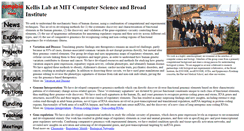 compbio.lehigh.edu
compbio.lehigh.edu
Wonpil Im Research Group
Research in our group is focused on the applications of theoretical/computational methods to chemical and physical problems in biology and material science. Specific research interests are: (see the details. Protein/peptide interactions with/in biological membranes. Transmembrane-induced signaling and regulation. NMR structure calculation and refinement. Modeling and simulation of glycoconjugates ( GlycanStructure.ORG. Bacterial outer membranes and interactions with proteins. As well as ST-analyzer.
 compbio.massey.ac.nz
compbio.massey.ac.nz
CompBio @ Massey University
These are webpages dedicated to computational biology and related deciplines at the Institute of Natural and Mathematical Sciences (INMS). In Albany, Auckland. The webpages are used to host information and news regarding people, courses, workshops, and conferences as well as research related tools and databases. Building 14, INMS. Station Crescent, Gate 4. Auckland, New Zealand. 64 9 414 0800 (ext: 43538). Gate 4, Building 11, INMS. Auckland 0630, New Zealand.
 compbio.math.pmf.unizg.hr
compbio.math.pmf.unizg.hr
compbio
At Department of Mathematics, University of Zagreb.
 compbio.med.harvard.edu
compbio.med.harvard.edu
Computational Genomics (PI: Peter J Park)
We are a bioinformatics research group and are part of the Center for Biomedical Informatics. At Harvard Medical School. Children's Hospital Informatics Program. Harvard-MIT Division of Health, Science, and Technology. And Division of Genetics at Brigham and Women's Hospital. More information on the principal investigator is here. Sep 1, 2014: Not a bad week for the Park lab: we had papers in. All in the same week! Oct 31, 2013: This time, congratulations to Francesco, Andrew! Davis et al. (pp. 3...Recen...
 compbio.med.wayne.edu
compbio.med.wayne.edu
Krawetz Lab
Charlotte B. Failing Professor of Fetal Therapy and Diagnosis. Associate Director C.S. Mott Center for Human Growth and Development,. Wayne State University School of Medicine. Department of Obstetrics and Gynecology. Center for Molecular Medicine and Genetics. Postdoctoral Positions Available - click here. C, Goodrich, R., Swanson, S., Hauser, R., Diamond, M. Click for Full Text. Johnson, G.D., Mackie. SA (2015 Jun 13. pii. Gkv591. [ Epub. Click for Full Text. Analysis methods to examine gene expression...
 compbio.mit.edu
compbio.mit.edu
Compbio.mit.edu - MIT Computational Biology Group - Kellis Lab at MIT and Broad Institute
We work in a highly interdisciplinary environment at the interface of computer science and biology. Members of the group come from a primarily computational background and share a strong passion for understanding biological systems. We are engaged in several collaborative research partnerships with biological and experimental collaborators, at the Broad Institute, the ENCODE, modENCODE, GTEx, and Epigenomics Roadmap consortia, the Harvard Medical School, and other universities. Read more on: Chromatin.
 compbio.ornl.gov
compbio.ornl.gov
Computational Biology at Oak Ridge National Laboratory
Welcome to Our Web Site. We are the Comparative Genomics and the Computational Biology and Bioinformatics Groups of the Biosciences Division of Oak Ridge National Laboratory. We conduct genetics research and system development in genomic sequencing, computational genome analysis, and computational protein structure analysis. Our collaborators include ORNL's Computer Science and Mathematics Division, the Joint Institute for Biological Sciences, and ORNL's Genome Science and Technology Graduate Program.
 compbio.ox.ac.uk
compbio.ox.ac.uk
CBRG, Oxford University
You are here: CBRG home. Search CBRG web site. Welcome to the CBRG. The Computational Biology Research Group (CBRG) provides computing support. For bioinformatics analysis at the University of Oxford. We have expertise in many aspects of bioinformatics (sequence analysis, microarrays, proteomics and integration). We especially encourage collaborations that require writing custom software, bioinformatics tools and databases. An account with the CBRG has many benefits. Bioinformatics analysis tools online:.
 compbio.snu.ac.kr
compbio.snu.ac.kr
Lab of Computational Biology and Biomolecular Engineering
Lab of Computational Biology and Biomolecular Engineering. 502-203 Department of Chemistry, Seoul National University, Seoul 08826, Republic of Korea.
 compbio.soihub.org
compbio.soihub.org
Computational Systems Biology
Please login to view:. If you would like to login and you do not already have an account please contact csb@soihub.org. Acknowledgements: This work was supported by NSF Grant DBI 0835677 and by the Center for Science of Information.
 compbio.sookmyung.ac.kr
compbio.sookmyung.ac.kr
NetCSSP.
Neural networks for calculating Contact-dependent Secondary Structure Propensity. Applications in predicting non-native secondary structures and amyloid fibril formation. 1 Select a method for CSSP calculation. Single network provides helical and beta propensity in a single profile while dual mode calculates the helical and. Beta propensities in two separate neural networks. Three ways to submit a query sequence. 2-1 Paste your protein sequence. PDB ID (4 letters) :. Type sequence (Single letter) :.






SOCIAL ENGAGEMENT